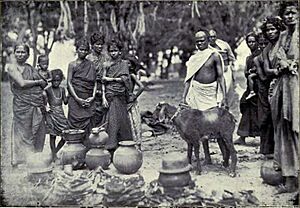Vanniyar facts for kids
The Vanniyar people, also known as the Palli, are a community mainly found in the northern part of the Indian state of Tamil Nadu.
For a long time, the Vanniyars were seen as a lower group in society. Since the 1800s, they have worked hard to gain a higher social and religious standing. They did this by using a process called Sanskritisation. This process helped them promote a story that they came from the ancient Agnikula deity, who was born from the flames of a fire sacrifice.
Contents
What Does the Name Vanniyar Mean?
There are a few ideas about where the name Vanniyar comes from. One idea is that it comes from the Sanskrit word vahni, which means "fire." This word is also linked to the Tamil word vanni, which is the name of an important tree. This connection to fire also links them to old stories and legends.
Other ideas suggest the name comes from the word val, meaning "strength," or vana, meaning "forest." The name Palli is also used for them, but many people in the community feel it is an old, disrespectful term.
Vanniyar's Place in History
In the past, society in South India was often divided into different groups, called varnas. The Vanniyar community was generally seen as part of the Shudra varna, which was considered a lower group. However, many communities in this region often tried to show that they had a higher status in history, sometimes based on myths or old stories.
By the early 1800s, the Vanniyar people started to reject being called a "low caste." They wanted to be seen as a higher group. Some researchers noted that even though they were traditionally classified among lower castes, the Pallis of Pondicherry liked to think of themselves as belonging to higher castes.
How the Vanniyars Changed Their Status
The Pallis, who later became known as Vanniyars, worked to change how they were seen. Before the 1871 Indian census, they asked to be recognized as part of the Kshatriya varna, which was the warrior class.
They created groups like the Vanniyakula Kshatriya Maha Sangam in 1888. This group helped them gain more recognition. By 1931, because of their successful efforts, the name Palli was removed from the Madras census. Instead, the term Vanniya Kula Kshatriya was used.
This change in their status, known as Sanskritisation, meant they started adopting new practices. For example, some began eating only vegetarian food and stopped allowing widows to remarry. They also claimed to be related to the ancient Pallava dynasty, which was a powerful ruling family.
Beyond these changes, the Vanniyars also had historical reasons for claiming a warrior status. They had used titles that showed they saw themselves as Kshatriyas. There is also evidence that Vanniyars were an important part of the Pallava army in the past. After the Pallava period, more proof showed Vanniyars taking on roles and activities linked to the Kshatriya warrior class.
The Vanniyar community has also been important in the worship of Draupati Amman. They might have even started this worship, with other communities joining later. In the past, some Vanniyars practiced polyandry, where one woman has multiple husbands. This practice might have been connected to their worship of Draupadi Amman.
Historically, some Vanniyar farmhands, called pannaiyals, were tied to their home village. They could not easily leave or be moved to another village, even if their masters left the area. This was a type of work arrangement within the traditional farming society.
Vanniyar's Status Today
In the 1980s, Vanniyars made up about 10% of Tamil Nadu's population. They were especially common in northern districts like Chingelput, North Arcot, South Arcot, and Salem, where they formed about 25% of the population. In the 1800s, Vanniyar/Palli people made up 30% of the population in Pondicherry.
Today, most Vanniyars are either small farmers or farm workers who do not own land. In 2003, it was reported that many were struggling because of rising debt in Tamil Nadu's farming sector. As a result, many now work as daily laborers in cities like Bengaluru and Chennai.
Because of their large population and where they live, the Vanniyars have a lot of political power in northern Tamil Nadu. The Pattali Makkal Katchi (PMK) is a political party started by S. Ramadoss from the Vanniyar Sangam, which is a community group. This party gets its support from Vanniyars.
The Vanniyars were once in the "Backward Class" category. But after successful protests in the 1980s, they were re-designated as a "Most Backward Caste." This change helped them get more benefits for education and jobs from the state government's reservation system. In 2020, the PMK pushed for a 20% reservation specifically for Vanniyars. This led the Tamil Nadu government to start a caste census.
Notable Vanniyar People
- S. S. Ramasami Padayatchiyar, a politician who founded the Tamil Nadu Toilers' Party
- Nagappan Padayatchi, an Indian South African who was a martyr for Satyagraha
- Vazhappady K. Ramamurthy, a politician who founded the Tamizhaga Rajiv Congress
- Chengalvaraya Naicker, a person known for helping others
- M. A. Manickavelu Naicker, a politician from the Indian National Congress and founder of the Commonweal Party
- Radhakrishna Padayachi, a South African cabinet minister and activist
- Anbumani Ramadoss, a politician and former Union Minister of Health and Family Welfare
- N. Rangaswamy, the Chief Minister of Puducherry
- Thenkachi Ko. Swaminathan, a Tamil speaker, television personality, and author
- Kaduvetti Guru, a politician and President of Vanniyar Sangam


